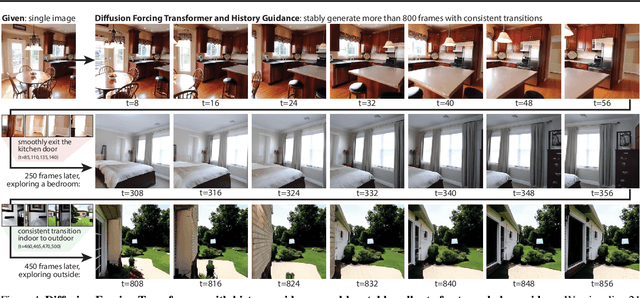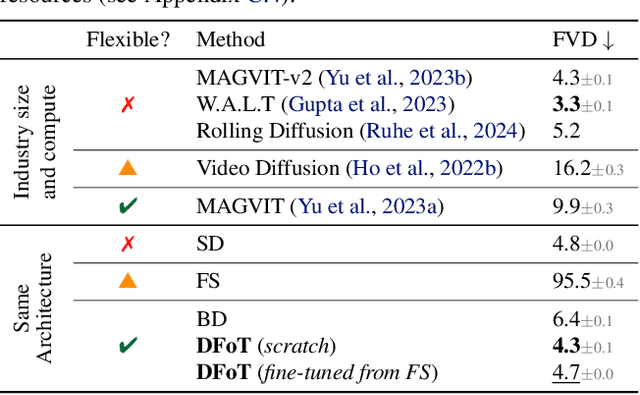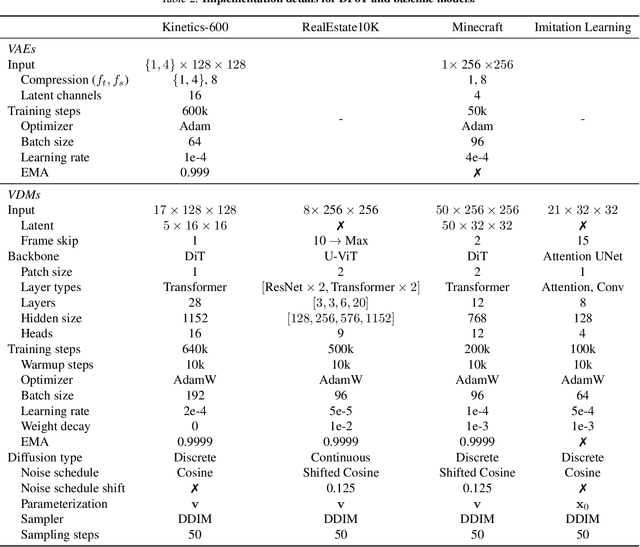Boyuan Chen
Jack
How Well do Diffusion Policies Learn Kinematic Constraint Manifolds?
Oct 01, 2025Abstract:Diffusion policies have shown impressive results in robot imitation learning, even for tasks that require satisfaction of kinematic equality constraints. However, task performance alone is not a reliable indicator of the policy's ability to precisely learn constraints in the training data. To investigate, we analyze how well diffusion policies discover these manifolds with a case study on a bimanual pick-and-place task that encourages fulfillment of a kinematic constraint for success. We study how three factors affect trained policies: dataset size, dataset quality, and manifold curvature. Our experiments show diffusion policies learn a coarse approximation of the constraint manifold with learning affected negatively by decreases in both dataset size and quality. On the other hand, the curvature of the constraint manifold showed inconclusive correlations with both constraint satisfaction and task success. A hardware evaluation verifies the applicability of our results in the real world. Project website with additional results and visuals: https://diffusion-learns-kinematic.github.io
Sym2Real: Symbolic Dynamics with Residual Learning for Data-Efficient Adaptive Control
Sep 18, 2025Abstract:We present Sym2Real, a fully data-driven framework that provides a principled way to train low-level adaptive controllers in a highly data-efficient manner. Using only about 10 trajectories, we achieve robust control of both a quadrotor and a racecar in the real world, without expert knowledge or simulation tuning. Our approach achieves this data efficiency by bringing symbolic regression to real-world robotics while addressing key challenges that prevent its direct application, including noise sensitivity and model degradation that lead to unsafe control. Our key observation is that the underlying physics is often shared for a system regardless of internal or external changes. Hence, we strategically combine low-fidelity simulation data with targeted real-world residual learning. Through experimental validation on quadrotor and racecar platforms, we demonstrate consistent data-efficient adaptation across six out-of-distribution sim2sim scenarios and successful sim2real transfer across five real-world conditions. More information and videos can be found at at http://generalroboticslab.com/Sym2Real
Pref-GUIDE: Continual Policy Learning from Real-Time Human Feedback via Preference-Based Learning
Aug 10, 2025Abstract:Training reinforcement learning agents with human feedback is crucial when task objectives are difficult to specify through dense reward functions. While prior methods rely on offline trajectory comparisons to elicit human preferences, such data is unavailable in online learning scenarios where agents must adapt on the fly. Recent approaches address this by collecting real-time scalar feedback to guide agent behavior and train reward models for continued learning after human feedback becomes unavailable. However, scalar feedback is often noisy and inconsistent, limiting the accuracy and generalization of learned rewards. We propose Pref-GUIDE, a framework that transforms real-time scalar feedback into preference-based data to improve reward model learning for continual policy training. Pref-GUIDE Individual mitigates temporal inconsistency by comparing agent behaviors within short windows and filtering ambiguous feedback. Pref-GUIDE Voting further enhances robustness by aggregating reward models across a population of users to form consensus preferences. Across three challenging environments, Pref-GUIDE significantly outperforms scalar-feedback baselines, with the voting variant exceeding even expert-designed dense rewards. By reframing scalar feedback as structured preferences with population feedback, Pref-GUIDE offers a scalable and principled approach for harnessing human input in online reinforcement learning.
InterMT: Multi-Turn Interleaved Preference Alignment with Human Feedback
May 29, 2025Abstract:As multimodal large models (MLLMs) continue to advance across challenging tasks, a key question emerges: What essential capabilities are still missing? A critical aspect of human learning is continuous interaction with the environment -- not limited to language, but also involving multimodal understanding and generation. To move closer to human-level intelligence, models must similarly support multi-turn, multimodal interaction. In particular, they should comprehend interleaved multimodal contexts and respond coherently in ongoing exchanges. In this work, we present an initial exploration through the InterMT -- the first preference dataset for multi-turn multimodal interaction, grounded in real human feedback. In this exploration, we particularly emphasize the importance of human oversight, introducing expert annotations to guide the process, motivated by the fact that current MLLMs lack such complex interactive capabilities. InterMT captures human preferences at both global and local levels into nine sub-dimensions, consists of 15.6k prompts, 52.6k multi-turn dialogue instances, and 32.4k human-labeled preference pairs. To compensate for the lack of capability for multi-modal understanding and generation, we introduce an agentic workflow that leverages tool-augmented MLLMs to construct multi-turn QA instances. To further this goal, we introduce InterMT-Bench to assess the ability of MLLMs in assisting judges with multi-turn, multimodal tasks. We demonstrate the utility of \InterMT through applications such as judge moderation and further reveal the multi-turn scaling law of judge model. We hope the open-source of our data can help facilitate further research on aligning current MLLMs to the next step. Our project website can be found at https://pku-intermt.github.io .
Mitigating Deceptive Alignment via Self-Monitoring
May 24, 2025Abstract:Modern large language models rely on chain-of-thought (CoT) reasoning to achieve impressive performance, yet the same mechanism can amplify deceptive alignment, situations in which a model appears aligned while covertly pursuing misaligned goals. Existing safety pipelines treat deception as a black-box output to be filtered post-hoc, leaving the model free to scheme during its internal reasoning. We ask: Can deception be intercepted while the model is thinking? We answer this question, the first framework that embeds a Self-Monitor inside the CoT process itself, named CoT Monitor+. During generation, the model produces (i) ordinary reasoning steps and (ii) an internal self-evaluation signal trained to flag and suppress misaligned strategies. The signal is used as an auxiliary reward in reinforcement learning, creating a feedback loop that rewards honest reasoning and discourages hidden goals. To study deceptive alignment systematically, we introduce DeceptionBench, a five-category benchmark that probes covert alignment-faking, sycophancy, etc. We evaluate various LLMs and show that unrestricted CoT roughly aggravates the deceptive tendency. In contrast, CoT Monitor+ cuts deceptive behaviors by 43.8% on average while preserving task accuracy. Further, when the self-monitor signal replaces an external weak judge in RL fine-tuning, models exhibit substantially fewer obfuscated thoughts and retain transparency. Our project website can be found at cot-monitor-plus.github.io
Generative RLHF-V: Learning Principles from Multi-modal Human Preference
May 24, 2025Abstract:Training multi-modal large language models (MLLMs) that align with human intentions is a long-term challenge. Traditional score-only reward models for alignment suffer from low accuracy, weak generalization, and poor interpretability, blocking the progress of alignment methods, e.g., reinforcement learning from human feedback (RLHF). Generative reward models (GRMs) leverage MLLMs' intrinsic reasoning capabilities to discriminate pair-wise responses, but their pair-wise paradigm makes it hard to generalize to learnable rewards. We introduce Generative RLHF-V, a novel alignment framework that integrates GRMs with multi-modal RLHF. We propose a two-stage pipeline: $\textbf{multi-modal generative reward modeling from RL}$, where RL guides GRMs to actively capture human intention, then predict the correct pair-wise scores; and $\textbf{RL optimization from grouped comparison}$, which enhances multi-modal RL scoring precision by grouped responses comparison. Experimental results demonstrate that, besides out-of-distribution generalization of RM discrimination, our framework improves 4 MLLMs' performance across 7 benchmarks by $18.1\%$, while the baseline RLHF is only $5.3\%$. We further validate that Generative RLHF-V achieves a near-linear improvement with an increasing number of candidate responses. Our code and models can be found at https://generative-rlhf-v.github.io.
LAPP: Large Language Model Feedback for Preference-Driven Reinforcement Learning
Apr 21, 2025Abstract:We introduce Large Language Model-Assisted Preference Prediction (LAPP), a novel framework for robot learning that enables efficient, customizable, and expressive behavior acquisition with minimum human effort. Unlike prior approaches that rely heavily on reward engineering, human demonstrations, motion capture, or expensive pairwise preference labels, LAPP leverages large language models (LLMs) to automatically generate preference labels from raw state-action trajectories collected during reinforcement learning (RL). These labels are used to train an online preference predictor, which in turn guides the policy optimization process toward satisfying high-level behavioral specifications provided by humans. Our key technical contribution is the integration of LLMs into the RL feedback loop through trajectory-level preference prediction, enabling robots to acquire complex skills including subtle control over gait patterns and rhythmic timing. We evaluate LAPP on a diverse set of quadruped locomotion and dexterous manipulation tasks and show that it achieves efficient learning, higher final performance, faster adaptation, and precise control of high-level behaviors. Notably, LAPP enables robots to master highly dynamic and expressive tasks such as quadruped backflips, which remain out of reach for standard LLM-generated or handcrafted rewards. Our results highlight LAPP as a promising direction for scalable preference-driven robot learning.
Empirical Analysis of Sim-and-Real Cotraining Of Diffusion Policies For Planar Pushing from Pixels
Mar 28, 2025Abstract:In imitation learning for robotics, cotraining with demonstration data generated both in simulation and on real hardware has emerged as a powerful recipe to overcome the sim2real gap. This work seeks to elucidate basic principles of this sim-and-real cotraining to help inform simulation design, sim-and-real dataset creation, and policy training. Focusing narrowly on the canonical task of planar pushing from camera inputs enabled us to be thorough in our study. These experiments confirm that cotraining with simulated data \emph{can} dramatically improve performance in real, especially when real data is limited. Performance gains scale with simulated data, but eventually plateau; real-world data increases this performance ceiling. The results also suggest that reducing the domain gap in physics may be more important than visual fidelity for non-prehensile manipulation tasks. Perhaps surprisingly, having some visual domain gap actually helps the cotrained policy -- binary probes reveal that high-performing policies learn to distinguish simulated domains from real. We conclude by investigating this nuance and mechanisms that facilitate positive transfer between sim-and-real. In total, our experiments span over 40 real-world policies (evaluated on 800+ trials) and 200 simulated policies (evaluated on 40,000+ trials).
PhysGen3D: Crafting a Miniature Interactive World from a Single Image
Mar 26, 2025Abstract:Envisioning physically plausible outcomes from a single image requires a deep understanding of the world's dynamics. To address this, we introduce PhysGen3D, a novel framework that transforms a single image into an amodal, camera-centric, interactive 3D scene. By combining advanced image-based geometric and semantic understanding with physics-based simulation, PhysGen3D creates an interactive 3D world from a static image, enabling us to "imagine" and simulate future scenarios based on user input. At its core, PhysGen3D estimates 3D shapes, poses, physical and lighting properties of objects, thereby capturing essential physical attributes that drive realistic object interactions. This framework allows users to specify precise initial conditions, such as object speed or material properties, for enhanced control over generated video outcomes. We evaluate PhysGen3D's performance against closed-source state-of-the-art (SOTA) image-to-video models, including Pika, Kling, and Gen-3, showing PhysGen3D's capacity to generate videos with realistic physics while offering greater flexibility and fine-grained control. Our results show that PhysGen3D achieves a unique balance of photorealism, physical plausibility, and user-driven interactivity, opening new possibilities for generating dynamic, physics-grounded video from an image.
History-Guided Video Diffusion
Feb 10, 2025



Abstract:Classifier-free guidance (CFG) is a key technique for improving conditional generation in diffusion models, enabling more accurate control while enhancing sample quality. It is natural to extend this technique to video diffusion, which generates video conditioned on a variable number of context frames, collectively referred to as history. However, we find two key challenges to guiding with variable-length history: architectures that only support fixed-size conditioning, and the empirical observation that CFG-style history dropout performs poorly. To address this, we propose the Diffusion Forcing Transformer (DFoT), a video diffusion architecture and theoretically grounded training objective that jointly enable conditioning on a flexible number of history frames. We then introduce History Guidance, a family of guidance methods uniquely enabled by DFoT. We show that its simplest form, vanilla history guidance, already significantly improves video generation quality and temporal consistency. A more advanced method, history guidance across time and frequency further enhances motion dynamics, enables compositional generalization to out-of-distribution history, and can stably roll out extremely long videos. Website: https://boyuan.space/history-guidance
 Add to Chrome
Add to Chrome Add to Firefox
Add to Firefox Add to Edge
Add to Edge